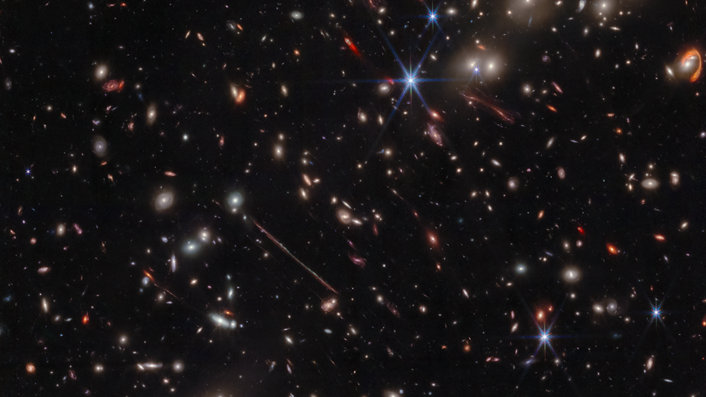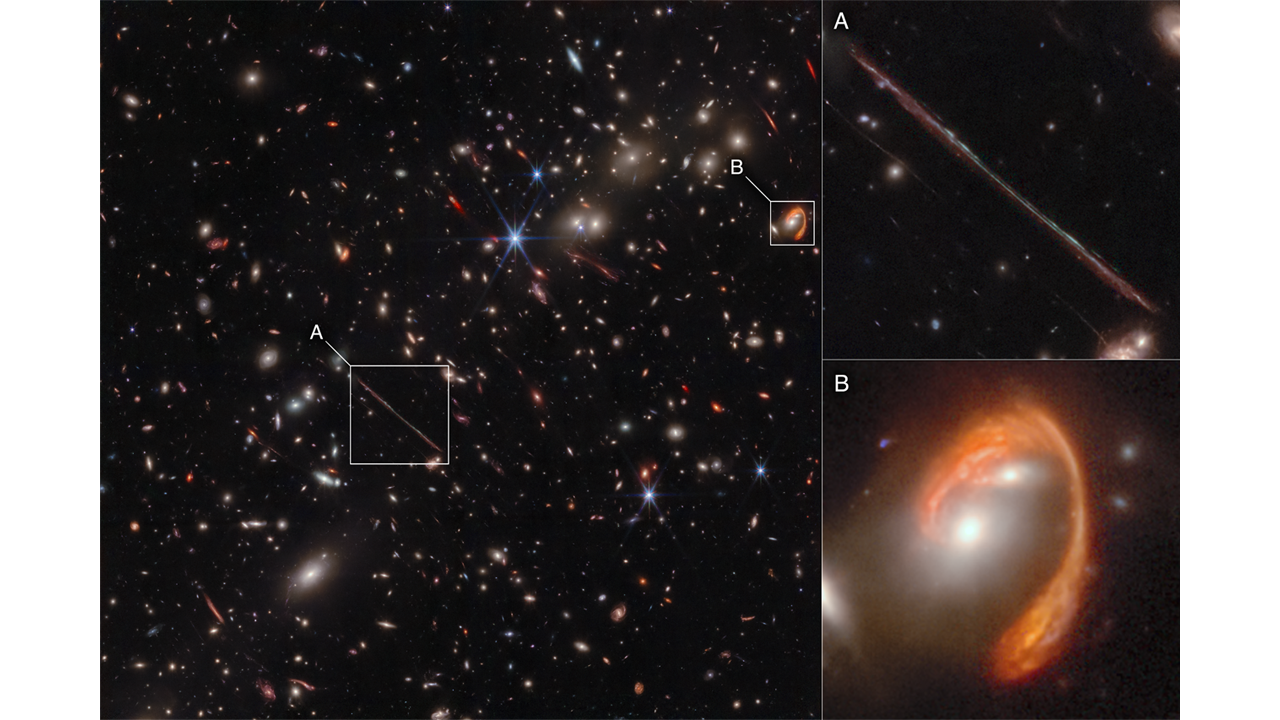James Webb Space Telescope unveils the gravitationally warped galaxies of 'El Gordo'
The enormous galaxy cluster, El Gordo, has been imaged by Hubble in the past — now, the JWST has offered us a fresh new view.

Sitting about 9.7 billion light-years from Earth lies a (very) hefty galaxy cluster with a mass equivalent to something like 3 million billion suns. It's a cosmic clump lovingly nicknamed El Gordo, which translates from Spanish to "The Fat One." Over the years, the Hubble Space Telescope has blessed us with some mesmerizing views of El Gordo — but now, there's a new space observatory in town.
On Wednesday (Aug. 2), scientists announced the James Webb Space Telescope has offered us a pretty mind-bending new perspective on El Gordo. With its infrared eyes, the trailblazing machine has revealed gravitationally distorted realms, a red giant star and tons of other space goodies Hubble could only hint at.
One subject, for instance, is known as "El Anzuelo," or "The Fishhook." Located 10.6 billion light-years away, this galaxy can be clearly seen toward the top right of the image as a bright red arc. To put into perspective how trippy this new photo is, you're seeing El Anzuelo as it was 10.6 billion years ago. This is because it took that long for light from this point in the galaxy's life to reach the JWST.
"We were able to carefully dissect the shroud of dust that envelops the galaxy center where stars are actively forming," Patrick Kamieneski of Arizona State University and lead author on one of several papers about these JWST observations, said in a statement. "With Webb, we can peer through this thick curtain of dust with ease, allowing us to see firsthand the assembly of galaxies from the inside out."
Related: James Webb Space Telescope's 'exquisite' 1st year has some astronomers in tears
But beyond the fact that the JWST is able to parse through dust veils, thanks to its infrared capabilities, this telescope's new lens on El Gordo is crucial because of how distinctly it can capture a phenomenon called gravitational lensing.
In short, gravitational lensing is a concept associated with Albert Einstein's theory of general relativity. This theory basically imagines space and time as woven together like a tangible fabric — a 4D sheet of silk that can warp and ripple depending on what masses are present within. Black holes warp this fabric a lot, stars affect it quite a bit, Earth warps it somewhat and even you and me warp it an incredibly tiny, indiscernible amount.
Breaking space news, the latest updates on rocket launches, skywatching events and more!
What's important for this JWST image, however, is that general relativity theory also predicts that those spacetime fabric warps impact the way light moves across the universe. At risk of simplification, the warps can force light to bend and twist while traveling through space — but this is a good thing for astronomers. If scientists can focus their observatories (like the JWST) on super-duper warped areas (like a hefty galaxy cluster), they can catch some of that warped light. And depending on where the light's coming from, those warps can create a sort of magnifying effect on the source. That effect is called gravitational lensing.
Returning to our image, the main reason we can see El Anzuelo at all, despite it living so immensely far away, is due to none other than gravitational lensing! And thanks to the spectacular concept, scientists realized the distant galaxy is disk-shaped, about 26,000 light-years in diameter (one-fourth the size of the Milky Way), in addition to dissecting other interesting information about its history.
Furthermore, the reddish tint you see in El Anzuelo has to do with another cosmic light phenomenon. Basically, as stuff gets farther and farther away from our vantage point on Earth — in conjunction with the universe's expansion — the lightwaves they emit stretch out like unbreakable rubber bands. As that happens, those waves appear redder and redder due to a phenomenon known as redshift.
So as this galaxy is looking quite red, it's quite far.
Underneath Einstein's magnifying glass
Because of how much gravitational lensing is apparent in this image – you can tell based on the fact that a bunch of glittering galaxies look like smudges rather than spirals and ellipticals we expect — there's a wealth of cosmic information to glean from it.
In fact, the JWST's very first image was also filled with a slew of gravitationally lensed galaxies, rightfully earning heaps of praise from space enthusiasts across the globe.
"This lensing effect provides a unique window into the distant universe," Brenda Frye of the University of Arizona, co-lead of the PEARLS-Clusters branch of the Prime Extragalactic Areas for Reionization and Lensing Science (PEARLS) team and lead author of another paper, said in the statement.
"Gravitational lensing was predicted by Albert Einstein more than 100 years ago. In the El Gordo cluster, we see the power of gravitational lensing in action," Rogier Windhorst of Arizona State University and principal investigator of the PEARLS program, said in the statement. "The PEARLS images of El Gordo are out-of-this-world beautiful. And, they have shown us how Webb can unlock Einstein's treasure chest."
Straying away from major galaxies, the JWST portrait of El Gordo also amazingly caught sight of a singular red giant star. Scientists nicknamed it Quyllur, which translates from the indigenous Quechua language of the Peruvian highlands to simply "star."
The amazing part? This marks the first individual red giant star observed by the JWST that's more than 1 billion light-years from Earth. Quyllur is actually located somewhere around 11 billion light-years away from us, near a galaxy known as La Flaca, or "The Thin One." La Flaca can be seen as a pencil-like line at the left-center of the image.
"It's almost impossible to see lensed red giant stars unless you go into the infrared. This is the first one we’ve found with Webb, but we expect there will be many more to come," Jose Diego of the Instituto de Física de Cantabria in Spain, lead author of another paper on El Gordo, said in the statement.
Frye and her team also point out five lensed galaxies that seem to be part of a baby cluster about 12.1 billion light-years from Earth – possibly holding a total of 17 galactic members. There are also some ultra-diffuse galaxies that appear present some 7.2 billion light-years away, which are similar to normal galaxies except their stars are much more spread out.
"We examined whether the properties of these galaxies are any different than the ultra-diffuse galaxies we see in the local universe, and we do actually see some differences. In particular, they are bluer, younger, more extended, and more evenly distributed throughout the cluster." Timothy Carleton of Arizona State University, lead author on another paper about these observations, said in the statement. "This suggests that living in the cluster environment for the past 6 billion years has had a significant effect on these galaxies."

Monisha Ravisetti is Space.com's Astronomy Editor. She covers black holes, star explosions, gravitational waves, exoplanet discoveries and other enigmas hidden across the fabric of space and time. Previously, she was a science writer at CNET, and before that, reported for The Academic Times. Prior to becoming a writer, she was an immunology researcher at Weill Cornell Medical Center in New York. She graduated from New York University in 2018 with a B.A. in philosophy, physics and chemistry. She spends too much time playing online chess. Her favorite planet is Earth.


